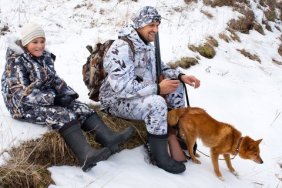 The outdoors market is rich with quality boots that are designed to withstand cold temperatures, water, and hazardous elements that might damage your feet otherwise. However, stuff happens, such as your boots becoming water-logged after an unexpected step in a deep puddle, prolonged trekking through deep snow, or any other scenario. What do you do when this happens, especially if frostbite is a potential threat? For starters, don’t worry. Then, once you’ve made camp, it’s time to pull of your socks and boots and employ a few of the tips outlined today.
The outdoors market is rich with quality boots that are designed to withstand cold temperatures, water, and hazardous elements that might damage your feet otherwise. However, stuff happens, such as your boots becoming water-logged after an unexpected step in a deep puddle, prolonged trekking through deep snow, or any other scenario. What do you do when this happens, especially if frostbite is a potential threat? For starters, don’t worry. Then, once you’ve made camp, it’s time to pull of your socks and boots and employ a few of the tips outlined today.
One method to dry your wet boots first involves removing the insoles and setting them aside. Then, pack your boots with absorbent materials, such as dry leaves and grasses. When those absorbent materials are thoroughly soaked, remove them and repeat the process until the interior of your boots is dry.
You can also use your surroundings to help dry wet boots. Heat dry stones in boiling water, or near the fire, and place them in a sock. Test the stones first to make sure they don't burn the material. If everything is good, stuff the rock-filled socks in your boots until they’re warm and dry.
While the interior of your boots is important to dry, it’s vital to not neglect your insoles. One way to dry insoles is to press them between spare clothing or dried grasses and then squeeze them to expel water. Afterward, I’d keep them in the bottom of your sleeping bag overnight to maintain dryness and warmth.
Normally, I wouldn’t recommend placing wet boots by the fire unless it’s your only option. If this is the case, be sure to not place them too close. Fire-baked leather will crack, synthetic material can melt, and insoles can harden in the fire’s heat, so be mindful of your boots’ materials.
When you make camp after a long day in wet conditions, be sure to employ the one or more of the tips mentioned above, as needed, to solve your soggy boot problems. Wet boots don’t have to leave you wallowing in sloshy misery, or facing the threat of frostbite, the next time you hit the trail. Keeping your feet warm, comfortable, and free from health risks will not only ensure a safe and enjoyable trip, but also that you’ll be able to keep hiking for years to come.
This article is brought to you by Energizer Fusion Lights. THese lights are a must have for your next campign trip with versatility and a light weight design, it will make your next adventure that much brighter.








